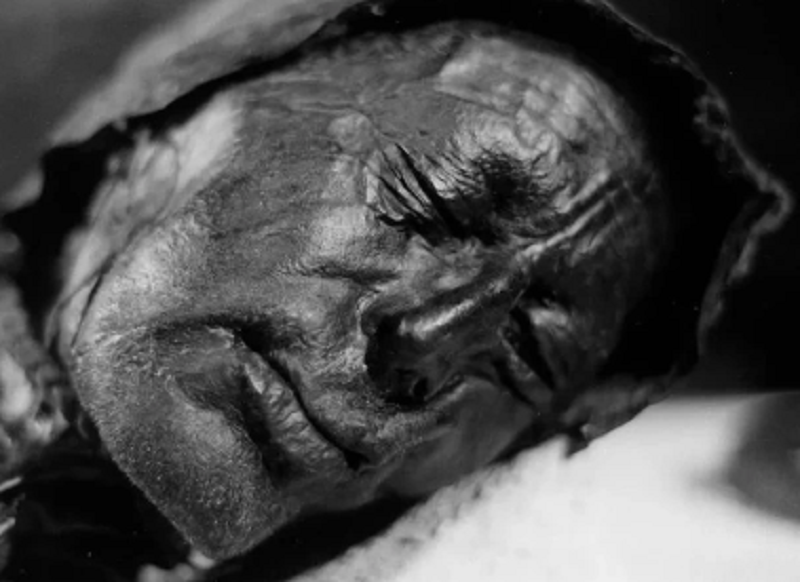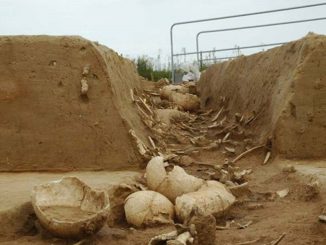One of the best-preserved “swamp bodies” in history, Tollund Man was discovered with a noose around his neck, leading researchers to conclude that he was the victim of human sacrifice .
On May 6, 1950, brothers Viggo and Emil Hojgaard were mining peat on the Jutland peninsula in Denmark when they accidentally discovered a body.
They immediately called the police thinking they had stumbled upon a recent murder victim. Although the body’s features suggested he had died recently, the body’s clothing suggested otherwise. He wore a pointed hat made of sheepskin and wool as well as a noose made of braided animal skin still around his neck. His skin, hair, and fingernails were leathery brown.
It was quickly determined that this was not a recent murder victim but instead a bog body – a corpse that had been naturally mummified and preserved in peat bogs for thousands of years .
This man was known as Tollund Man after the nearby Danish village, and the fact that his body was so well preserved after two millennia is still shocking today.
Tollund Man’s body can be seen at the Silkeborg Museum in Denmark. However, most of the bodies were withered due to poor preservation techniques at the time of discovery. Only the head, feet and thumbs are kept in their original state.
Carbon dating determined that Tollund Man’s remains were more than 2,000 years old, dating from approximately 405 to 380 BC, during the pre-Roman Iron Age in Scandinavia. The man was estimated to be around 40 years old when he died – hanged.
Although it has been suggested that Tollund Man may have been executed because he was a criminal, most experts “tend to agree that his killing was a kind of ritual sacrifice to the gods ”, according to information from Smithsonian.
Tollund Man’s facial features and internal organs, including his heart, lungs and liver, are surprisingly well preserved, although the skin on his arms and hands is reduced to tissue. and bones harden. The body was placed in a fetal position, eyes closed and mouth relaxed into a weak smile.
Tollund Man was in such good condition that when discovered, scientists were able to take his fingerprints. Even Tollund Man’s internal organs were found to be in good condition and stomach analysis showed that he had eaten his last meal between 12 and 24 hours before his death. Based on the ingredients, this meal could be a type of porridge made mainly from flaxseed and barley.

Swamp bodies like Tollund Man have been found in peat bogs across Northern Europe.
The majority of bog bodies like Tollund Man were excavated in Northern Europe and date to the Bronze and Iron Ages.
According to author Christian Fischer in his book “Mummies, Disease and Ancient Culture”, it is estimated that 122 complete bog bodies have been found and can be identified, although some estimates put the number up to 1,400.
According to Smithsonian, nearly all of the bodies found in the swamp appeared to have been killed in some form of ritual sacrifice or punishment. According to archeology professor and author Peter Vilhelm Glob, the bodies may have been sacrificed to the pagan goddess Nerthus, also known as Mother Earth, who was associated with peace and prosperity.
The first recorded bog bodies were found in the 17th century. One was discovered in Germany in 1640, believed to be the first bog body discovered, and a peat cutter in Northern Ireland found another mummy in 1780, leading to what is believed to be the first published account of bog bodies.
To date, the oldest bog body discovered is known as Koelbjerg Man, whose remains have been dated to around 8,000 BC. His entire body was not found, just a skull and bone fragments, but this is the oldest human skeleton ever found in Denmark.
Many historians believe that many of the bodies in this swamp may be related to each other. This theory was bolstered by the discovery of another swamp body just 260 feet (about 80 meters) from where Tollund Man was found.
Tollund Man is extremely well preserved thanks to the environmental conditions of the bog.
Swamp bodies like Tollund Man are often said to be “naturally mummified” due to the bodies being incredibly preserved by natural elements.
The water in peat mines is highly acidic due to their proximity to cold saltwater bodies, such as Scandinavia’s North Sea. The high salt content allows peat moss to grow freely in bogs, and as the moss rots, it releases significant amounts of acid into the bog.
According to the Silkeborg Museum, the water in these swamps has a pH nearly balanced with vinegar, causing any human remains left in the swamp to be preserved in the same way as vegetables soaked in vinegar – The acid prevents bacteria from thriving, which can cause the body to deteriorate and decompose.
All the bodies in the swamp were placed in water during the winter, when the water temperature was lower than 4 degrees Celsius. These temperatures are similar to those of a refrigerator and prevent bacteria from growing.




